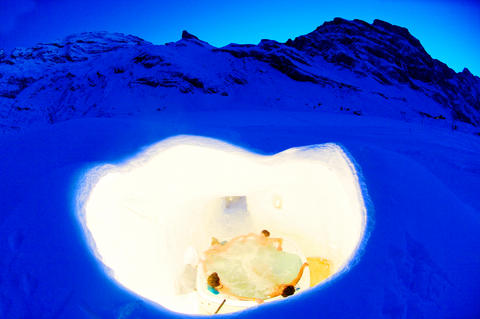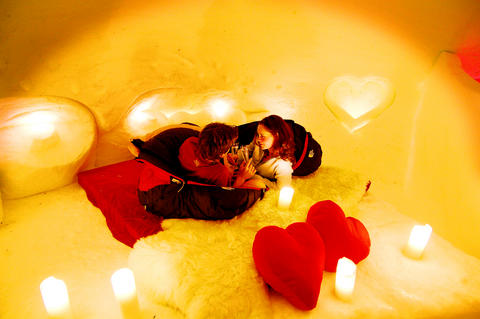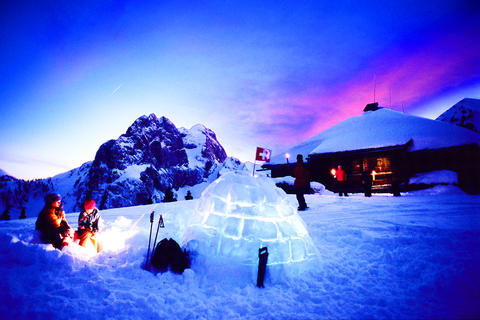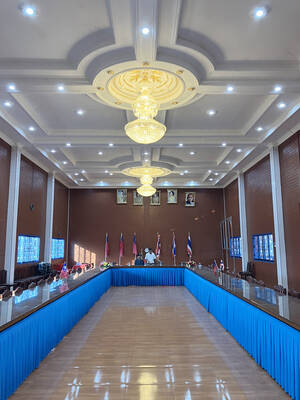Should we really take lessons in romance from the Eskimos? While the French lock tongues, they just rub noses - and it must be hard to persuade a lover to get their kit off when it's 30 below.
My boyfriend and I are about to find out: we are making our way to a Swiss igloo 1,500m up a mountain above Gstaad. We catch the last lift up. It's gone 4pm and as we swing through the trees, skiers sketch out the final tracks of the day on the pistes below. A devoted few are juggling their skis into the racks of the bubble lifts to catch one more run, but we're clutching overnight bags, toothbrushes and warm pyjamas tucked inside.
Heading uphill for the night is exciting whether you're staying in a mountain refuge or a luxury lodge, but now a handful of Swiss resorts - Zermatt, Engelberg, Davos, Zugspitze and Gstaad - offer a more unusual place to kip: an igloo. Everyone is welcome, but the company is keen to promote the experience as a romantic break for couples, especially around Valentine's Day.

PHOTO: COURTESY OF GSTAAD SAANENLAND TOURISMUS
The smiling lovers in the brochure look mushy enough, gazing at each other from piles of furs and heart-shaped cushions. But I'm not sure how it easy it is for love to burn in a cold climate.
There's just time for a quick vin chaud in Mountain Restaurant Eggli, where we sit on wooden benches wrapped in fleece blankets, following the sun's arc into the horizon behind the toothy mountains. Our guide and the other would-be Eskimos turn up for a brief introductory talk, then we slither down a gentle ski slope to the Iglu Dorf. From the front it looks like a wall of ice, and shadows and candlelight lick its decorative sculpted patterns. During the day skiers meet at the external bar here, but only guests are allowed inside.
Chunky stools are angled perilously a few meters up the slope, perfectly positioned (as long as you don't mind wobbling off them a couple of times) for sky watching. Glasses of Prosecco arrive with a plate of local ham and we gawp up at the encircling peaks, turning copper, orange, lilac and midnight blue.

PHOTO: COURTESY OF GSTAAD SAANENLAND TOURISMUS
WINTER WONDERLAND
Time to go inside, I think: it's getting nippy out here. But of course, it's no warmer in than out. Creeping into the igloo has the unforgettable thrill of doing something completely new and different. Sound stops. The wind hushes and the air slows down, and pale blue fills your vision. It's like going into a cave or behind a waterfall, inside a part of nature that we're not supposed to see.
Honeyed candlelight floods the grand dining room, softening its domed ceiling and pink-tinged alcoves. The smooth walls and curved roof are made by inflating giant balloons, covering them with snow and packing it down before the balloon is popped and removed, leaving the sturdy structure. Muddy streaks dirty the walls slightly - there was apparently a shortage of virgin snow - but it's still impressive and beautiful.

PHOTOS: COURTESY OF GSTAAD SAANENLAND TOURISMUS
We are led along the corridor that rings the central space and couples peel off into circular bedrooms along its length. One, the romantic suite, has a Jacuzzi on a patio area, sheltered by a high ice wall. We don't expect to see much of that couple tonight. You can't make doors out of ice, so red velvet curtains hang across the doorways, but they don't quite cover the gap. People walking past will be able to see inside - is this to stop guests getting up to anything in the double sleeping bags?
The romance is slightly lost at dinner, too, which is a communal affair, with six or so people round one fondue. That's all we get, and it's a bit sickly a few dips in, but the other guests are jolly and there's plenty of wine on tap, drunk from polystyrene cups which we have to write our names on so we can reuse them and reduce waste. The igloo is very environment-friendly, leaving no mark on the landscape and using minimal power.
We slump in soft chairs outside and buy a few shots from the bar. In this dip in the mountains, away from light pollution, the stars look as bright as traffic lights and the effect, against the spectral white outlines of the mountain, is magical. Why then, did someone select the very worst 1980s ballads and 1970s soft rock as a sound track, when trippy dance music, or even something classical, could have heightened the atmosphere? It's nice to return from our romantic break with a new "our song"; odd that it should be Supertramp's Bloody Well Right.
Would we like to walk up the hill to go sledging, asks the guide. Well, maybe ... but didn't he say something about a sauna? While the others trudge off for high jinks in the snow, we grab the chance to enjoy the little wooden sauna by ourselves, and stop shivering for the first time in hours.
Going back into the ice house is a wrench, but soon we're wiggling into a two-man, expedition-grade sleeping bag to bed down on our ice platform. Foam mattresses and furs provide insulation; the heart-shaped cushions make us feel silly. Undressing in a cocoon is a Houdini-esque task, but we should do as we're told and store our clothes at the bottom of the bag to keep our feet warm. Sleeping naked, as the Inuits apparently do, is also advised, but the thought of all the other bodies that have been bagged up in here this season puts us off.
Something about cold on the face, mountain air and silence makes for a perfect sleep, though hopping down the corridor to the loo (thank the yetis it's a proper one, with a door and a flush) in the dead of night, clad only in thermal undies, is painfully cold. We're wretchedly dehydrated too: there's no water anywhere, so there's nothing for it but to thieve some tonic water from the bar - or lick the walls.
THE MORNING AFTER ...
Dawn comes and the guide is shouting through the red curtain about breakfast in the mountain lodge, so we drag our bones out into the granite gardens of the Bernese Oberland. The iceberg-crisp morning is spectacular, and the swish swish of skiers has not yet begun.
We change in the storeroom where we left our suitcases, and catch the first lift down as skiers swing up in the opposite direction. Gstaad is very pretty, upmarket and car-free: its fairy-lit streets lined with chalets, its bars lined with rich couples in furs. It's a lovely place to visit even if you don't ski. Not to be missed is a meal in the Chesery, the town's most exclusive restaurant. Peachy candlelight and soft jazz, champagne and superb food prepared with precision and flair: romance by numbers, surely?
But it doesn't have the same magic as sitting mitten in mitten, freezing your bum off in a wonky deck chair under the stars with the dulcet tones of Supertramp's Roger Hodgson echoing over the peaks.
Further info: iglu-dorf.com; www.gstaad.ch/winter/gs-index.htm.

May 26 to June 1 When the Qing Dynasty first took control over many parts of Taiwan in 1684, it roughly continued the Kingdom of Tungning’s administrative borders (see below), setting up one prefecture and three counties. The actual area of control covered today’s Chiayi, Tainan and Kaohsiung. The administrative center was in Taiwan Prefecture, in today’s Tainan. But as Han settlement expanded and due to rebellions and other international incidents, the administrative units became more complex. By the time Taiwan became a province of the Qing in 1887, there were three prefectures, eleven counties, three subprefectures and one directly-administered prefecture, with

Taiwan Power Co (Taipower, 台電) and the New Taipei City Government in May last year agreed to allow the activation of a spent fuel storage facility for the Jinshan Nuclear Power Plant in Shihmen District (石門). The deal ended eleven years of legal wrangling. According to the Taipower announcement, the city government engaged in repeated delays, failing to approve water and soil conservation plans. Taipower said at the time that plans for another dry storage facility for the Guosheng Nuclear Power Plant in New Taipei City’s Wanli District (萬里) remained stuck in legal limbo. Later that year an agreement was reached

What does the Taiwan People’s Party (TPP) in the Huang Kuo-chang (黃國昌) era stand for? What sets it apart from their allies, the Chinese Nationalist Party (KMT)? With some shifts in tone and emphasis, the KMT’s stances have not changed significantly since the late 2000s and the era of former president Ma Ying-jeou (馬英九). The Democratic Progressive Party’s (DPP) current platform formed in the mid-2010s under the guidance of Tsai Ing-wen (蔡英文), and current President William Lai (賴清德) campaigned on continuity. Though their ideological stances may be a bit stale, they have the advantage of being broadly understood by the voters.

In a high-rise office building in Taipei’s government district, the primary agency for maintaining links to Thailand’s 108 Yunnan villages — which are home to a population of around 200,000 descendants of the Chinese Nationalist Party (KMT) armies stranded in Thailand following the Chinese Civil War — is the Overseas Community Affairs Council (OCAC). Established in China in 1926, the OCAC was born of a mandate to support Chinese education, culture and economic development in far flung Chinese diaspora communities, which, especially in southeast Asia, had underwritten the military insurgencies against the Qing Dynasty that led to the founding of